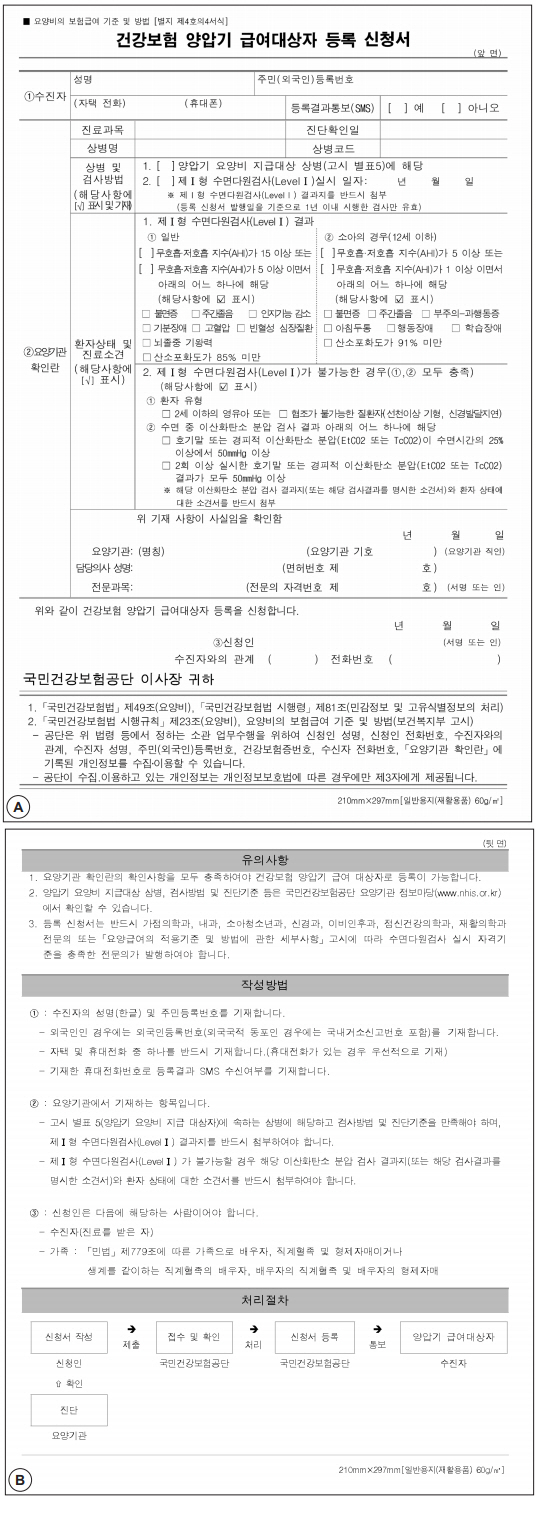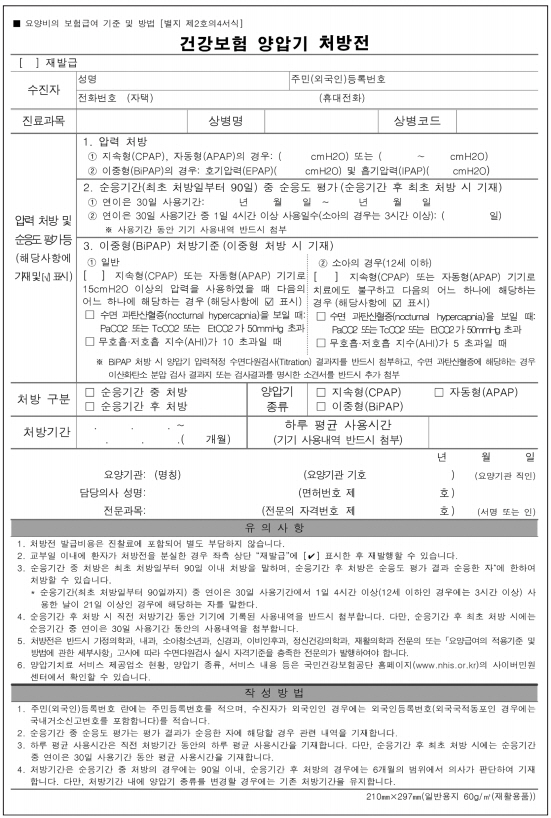J Rhinol.
2020 Nov;27(2):73-82. 10.18787/jr.2020.00319.
Positive Airway Pressure Prescription and Management for Patients with Obstructive Sleep Apnea
- Affiliations
-
- 1Department of Otorhinolaryngology-Head and Neck Surgery, Soonchunhyang University College of Medicine, Bucheon Hospital, Bucheon, Korea
- KMID: 2508950
- DOI: http://doi.org/10.18787/jr.2020.00319
Abstract
- Obstructive sleep apnea (OSA) is characterized by repeated events of complete or partial upper airway obstruction during sleep and is a chronic sleep disorder that requires long-term comprehensive management. Positive airway pressure (PAP) is recommended for treatment of OSA in adults with excessive daytime sleepiness, decreased sleep-related quality of life, and comorbid hypertension. During PAP therapy, regular follow-up is continuously necessary to evaluate side effects or complications, compliance, and treatment effects such as OSA-related symptoms, quality of life, and consequences. This review provides knowledge about PAP-related background information, indications for PAP prescription including the Korean National Health Insurance criteria, optimal pressure, PAP modes, patient education and support, short-term and long-term management, interpretation of PAP uses, and alternative therapies.
Keyword
Figure
Cited by 2 articles
-
Compliance After Re-Prescription for Positive Airway Pressure in Obstructive Sleep Apnea Patients Who Failed Positive Airway Pressure Therapy
Jeonghyun Lee, JunYeong Jeong, Jaeha Lee, Jae Yong Lee, Ji Ho Choi
J Rhinol. 2022;29(3):148-154. doi: 10.18787/jr.2022.00417.Trends in Palate Surgery for Obstructive Sleep Apnea in Korea Over the Past 12 Years
Jae Hoon Cho, Ji Ho Choi
J Rhinol. 2023;30(3):129-134. doi: 10.18787/jr.2023.00040.
Reference
-
1. Epstein LJ, Kristo D, Strollo PJ Jr, Friedman N, Malhotra A, Patil SP, et al. Clinical guideline for the evaluation, management and long-term care of obstructive sleep apnea in adults. J Clin Sleep Med. 2009; 5:263–76.2. Gottlieb DJ, Punjabi NM. Diagnosis and management of obstructive sleep apnea: a review. JAMA. 2020; 323:1389–400.3. Guilleminault C, Tilkian A, Dement WC. The sleep apnea syndromes. Annu Rev Med. 1976; 27:465–84.4. Strollo PJ Jr, Rogers RM. Obstructive sleep apnea. N Engl J Med. 1996; 334:99–104.5. Caples SM, Garcia-Touchard A, Somers VK. Sleep-disordered breathing and cardiovascular risk. Sleep. 2007; 30:291–303.6. Liu L, Kang R, Zhao S, Zhang T, Zhu W, Li E, et al. Sexual dysfunction in patients with obstructive sleep apnea: a systematic review and meta-analysis. J Sex Med. 2015; 12:1992–2003.7. Shastri A, Bangar S, Holmes J. Obstructive sleep apnoea and dementia: is there a link? Int J Geriatr Psychiatry. 2016; 31:400–5.8. Yaffe K, Laffan AM, Harrison SL, Redline S, Spira AP, Ensrud KE, et al. Sleep-disordered breathing, hypoxia, and risk of mild cognitive impairment and dementia in older women. JAMA. 2011; 306:613–9.9. Nieto FJ, Peppard PE, Young T, Finn L, Hla KM, Farré R. Sleep-disordered breathing and cancer mortality: results from the Wisconsin Sleep Cohort Study. Am J Respir Crit Care Med. 2012; 186:190–4.10. Choi JH, Lee JY, Han KD, Lim YC, Cho JH. Association between obstructive sleep apnoea and breast cancer: The Korean National Health Insurance Service Data 2007-2014. Sci Rep. 2019; 9:19044.11. Patil SP, Ayappa IA, Caples SM, Kimoff RJ, Patel SR, Harrod CG. Treatment of adult obstructive sleep apnea with positive airway pressure: an american academy of sleep medicine clinical practice guideline. J Clin Sleep Med. 2019; 15:335–43.12. Aurora RN, Casey KR, Kristo D, Auerbach S, Bista SR, Chowdhuri S, et al. Practice parameters for the surgical modifications of the upper airway for obstructive sleep apnea in adults. Sleep. 2010; 33:1408–13.13. Ramar K, Dort LC, Katz SG, Lettieri CJ, Harrod CG, Thomas SM, et al. Clinical practice guideline for the treatment of obstructive sleep apnea and snoring with oral appliance therapy: an update for 2015. J Clin Sleep Med. 2015; 11:773–827.14. Morgenthaler TI, Kapen S, Lee-Chiong T, Alessi C, Boehlecke B, Brown T, et al. Practice parameters for the medical therapy of obstructive sleep apnea. Sleep. 2006; 29:1031–5.15. Peppard PE, Young T, Palta M, Dempsey J, Skatrud J. Longitudinal study of moderate weight change and sleep-disordered breathing. JAMA. 2000; 284:3015–21.16. Lee E, Choi JH, Lee B, Jung JH, Seon SW, Lee S, et al. Effect of positional therapy on patients with obstructive sleep apnea: meta-analysis. J Rhinol. 2017; 24:94–103.17. Ryan CF. Sleep x 9: an approach to treatment of obstructive sleep apnoea/hypopnoea syndrome including upper airway surgery. Thorax. 2005; 60:595–604.18. Kakkar RK, Berry RB. Positive airway pressure treatment for obstructive sleep apnea. Chest. 2007; 132:1057–72.19. Sullivan CE, Issa FG, Berthon-Jones M, Eves L. Reversal of obstructive sleep apnoea by continuous positive airway pressure applied through the nares. Lancet. 1981; 1:862–5.20. Gay P, Weaver T, Loube D, Iber C. Evaluation of positive airway pressure treatment for sleep related breathing disorders in adults. Sleep. 2006; 29:381–401.21. Kushida CA, Littner MR, Hirshkowitz M, Morgenthaler TI, Alessi CA, Bailey D, et al. Practice parameters for the use of continuous and bilevel positive airway pressure devices to treat adult patients with sleep-related breathing disorders. Sleep. 2006; 29:375–80.22. Patil SP, Ayappa IA, Caples SM, Kimoff RJ, Patel SR, Harrod CG. Treatment of adult obstructive sleep apnea with positive airway pressure: an American Academy of Sleep Medicine systematic review, meta-analysis, and GRADE assessment. J Clin Sleep Med. 2019; 15:301–34.23. Insurance payment standards and methods for medical expenses. Ministry of Health and Welfare Notification No. 2018-138.24. Kushida CA, Chediak A, Berry RB, Brown LK, Gozal D, Iber C, et al. Clinical guidelines for the manual titration of positive airway pressure in patients with obstructive sleep apnea. J Clin Sleep Med. 2008; 4:157–71.25. Kushida CA, Littner MR, Morgenthaler T, Alessi CA, Bailey D, Coleman J Jr, et al. Practice parameters for the indications for polysomnography and related procedures: an update for 2005. Sleep. 2005; 28:499–521.26. Littner M, Hirshkowitz M, Davila D, Anderson WM, Kushida CA, Woodson BT, et al. Practice parameters for the use of auto-titrating continuous positive airway pressure devices for titrating pressures and treating adult patients with obstructive sleep apnea syndrome. An American Academy of Sleep Medicine report. Sleep. 2002; 25:143–7.27. Berry RB, Parish JM, Hartse KM. The use of auto-titrating continuous positive airway pressure for treatment of adult obstructive sleep apnea. An American Academy of Sleep Medicine review. Sleep. 2002; 25:148–73.
- Full Text Links
- Actions
-
Cited
- CITED
-
- Close
- Share
- Similar articles
-
- Massive REM Rebound on Continuous Positive Airway Pressure in Obstructive Sleep Apnea
- The Role of Endothelin-1 in Obstructive Sleep Apnea Syndrome and Pulmonary Hypertension
- Compliance After Re-Prescription for Positive Airway Pressure in Obstructive Sleep Apnea Patients Who Failed Positive Airway Pressure Therapy
- CPAP Treatment in Pediatric Obstructive Sleep Apnea
- A Sleepy Man with Chronic Obstructive Pulmonary Disease-Obstructive Sleep Apnea Overlap Syndrome



